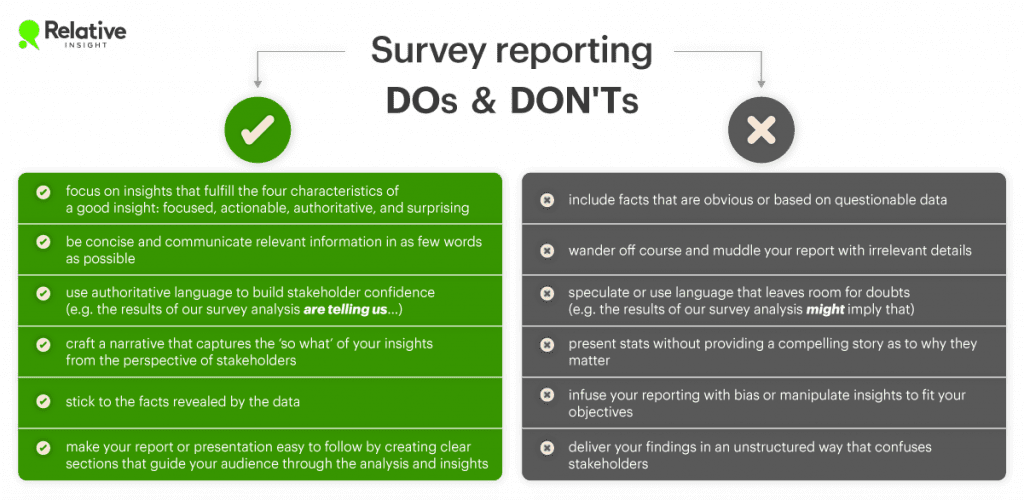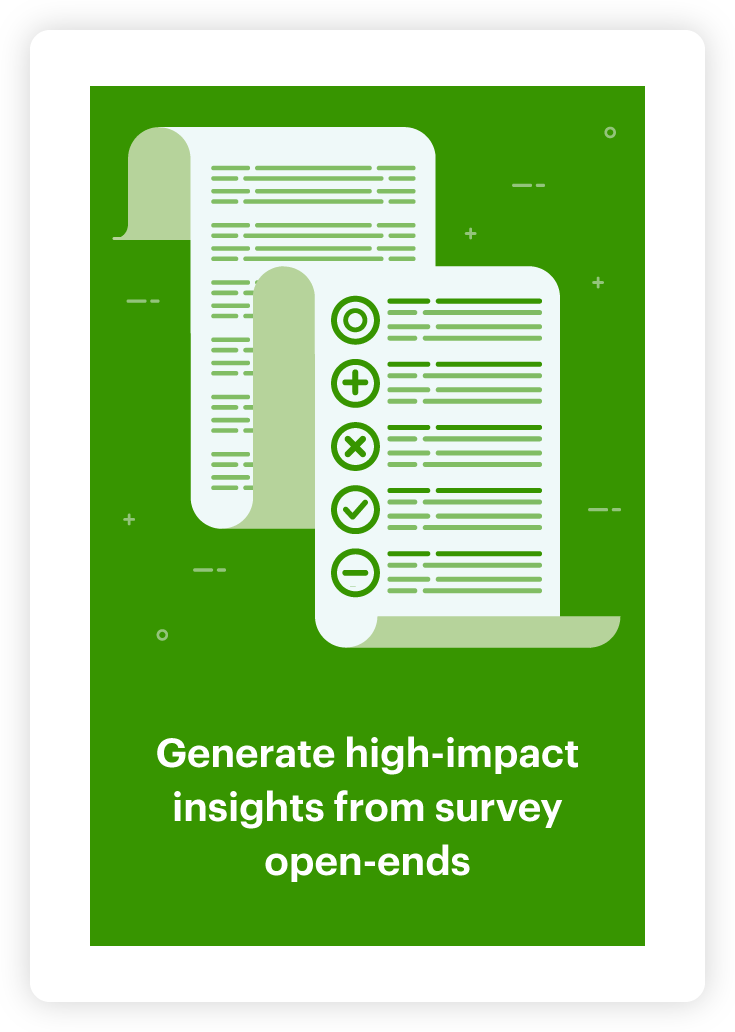Survey reporting: Transforming data into insights and action plans

You’ve created your survey, collected high-quality representative feedback and generated valuable insights from your survey analysis – unfortunately, this isn’t where the work ends.
In order for your survey insights to have a business impact (this is, after all, the reason you’re conducting a survey in the first place), you have to craft a compelling, data-driven narrative and deliver it to stakeholders in a way that resonates.
Effective survey reporting is the key to accomplishing this and as such should be considered an essential component of your survey data analysis. In fact, companies that use data effectively to generate business insights have the potential to grow more than 30% each year!
But where do you begin? What even is a survey analysis report? And what needs to be included to ensure the resulting insights have the desired impact?
In this article, we’ve broken down everything you need to know about survey reporting:
What is a survey analysis report and why is it important?
Survey analysis reports provide stakeholders with data-driven insights that help them make informed, customer-centric business decisions. They bridge the gap between insights and action, articulating what the survey data is saying against the context of stakeholders’ priorities.
Organizations can use this overview of survey data to inform product development, amend customer service processes, identify operational issues, tailor marketing communications and ultimately make better decisions that increase revenue and growth.
Businesses conduct surveys for a number of reasons – most commonly for market research, to assess customer satisfaction or employee experience. The overarching goal is to use the findings uncovered through survey analysis to make better, data-backed business decisions.
To put it simply: compelling survey reporting is a vehicle for delivering the most important and relevant findings from a survey and inspiring stakeholders to take action.
What is included in a survey analysis report?
Having learned what survey reporting is and why you should give special attention to this crucial part of your survey analysis process, you’re probably eager to know: what is included in a survey analysis report and how do you structure a survey report?

Let’s dive into the four key components of a good survey analysis report:
1. Lay out the most important conclusions and potential implications
As with any introduction, the introduction to your survey report needs to capture your stakeholders’ attention.
How do you do that? Showcase the most captivating findings, without going into too much detail – you’ll want to convey the headlines of your survey data analysis while creating enough curiosity so that people want to keep reading or listening to what you have to say.
Don’t assume everyone will read the full report, get the most important information out right away. You can explain the details behind it later in the report.
It’s also important to briefly explain the purpose of the survey.
Pro tip: write this section of your survey report or presentation at the end. Once you have a clear overview of everything you want to communicate, it is easier to boil things down to the key takeaways.
2. Describe the audience and methodology
You might’ve guessed it – after capturing your stakeholders’ attention with the most important headlines, it’s time to reflect on your research objectives, what type of survey you conducted, the kinds of questions you asked, the analysis methodology and who your target audience was.
It’s important that you help people understand who was surveyed (and who wasn’t) so they can understand the context around who they’re learning about. Remember that no survey is perfect and be sure to acknowledge where there might be gaps so people don’t make misguided conclusions.
Pro tip: When articulating methodology, think about who your stakeholders are. Different levels of detail are likely to be warranted when talking to a marketing director vs. a data scientist.
3. Key insights
As a next step, you should dive deeper into the insights revealed by your survey analysis. This is your opportunity to get into the detail and data points behind the key insights you introduced at the outset of your report or presentation.
This part of your survey summary report should include:
- Insights uncovered through your quantitative and qualitative survey analysis
- Data points that support your findings
- Intuitive visualizations such as graphs, tables and charts
Pro tip: Using charts, graphs, stats and verbatim quotes will help you tell the story of what’s happening in the data. Blending stats with qualitative snippets is a great way to tell your story and provide the necessary context.
4. Suggested actions
The final, and arguably most important, component of any survey analysis report is all about communicating the ‘so what’ of the insights you’ve uncovered.
Refrain from simply summarizing your findings – instead, focus on relaying why the insights you uncovered matter and what stakeholders can do with this newly acquired knowledge. Here is where you have to convey the all-important who, what, why and what’s next of your insights, compelling stakeholders to take action.
Pro tip: Revisit the key points from your intro, articulating what this means for your stakeholders. Always try to be specific and provide options but be careful to recommend and not tell – after all, your stakeholders know their world the best.
Survey reporting best practices
Equipped with this extensive knowledge regarding the content and structure of a good survey results report, you are just about ready to tackle your survey reporting. But before you start writing, let’s dive into some dos and don’ts to ensure you’re on the right track:

Identify key insights
What’s the foundation of any good survey reporting? High-quality insights that are interesting and actionable.
But beware – although the terms information and insight are often used interchangeably, they are not the same! While both are derived from data, insights provide context and a ‘so what’ that can be used to drive action.
That being said, make sure to steer clear of “just” providing information that has no associated ‘so what’ and only focus on the most important insights that carry business implications. Spreading your focus across too many insights in your survey analysis report or presentation will overwhelm your stakeholders and steer the focus away from what is truly important.
Include data visualizations
A surefire way to keep your stakeholders engaged throughout your survey reporting? Survey analysis visualizations!
Examples of such visualizations include graphs, graphics, tables and other types of data overviews. Regardless of which types of visuals you choose to include, ensure that they can be easily understood and function as a tool to convey complex ideas or concepts.
Frame your summary of survey results as a compelling narrative
Effective storytelling is crucial!
Nobody wants to be presented with boring stats and numbers. Your stakeholders want to hear a compelling narrative based on your survey analysis insights that communicates the ‘so what’ of your quantitative and qualitative survey data.
Survey analysis report example and template
We understand that survey reporting might sound easier in theory than it is in practice but don’t fret – we weren’t about to leave you hanging!
To illustrate what a good sample survey analysis report could look like, we’ve created a downloadable survey analysis report example for you.
How do you present a survey analysis report?
As you well know, a good survey results report will only drive meaningful action and inspire stakeholders if you present your findings or deliver a written report to stakeholders.
The good news is that if you’ve followed our recommendations and best practices, you have every reason to be confident! Here are a few presentation tips to guide you:
- Know what story you are trying to tell: A run-through with a friendly colleague can help you iterate your story and iron out any points of potential confusion.
- Be confident in your approach: You’re the expert in survey analysis so remember to act like it!
- Give just enough detail to make your points clear: Unnecessary details can distract from your narrative and steer your presentation off course.
- Prepare for questions: if stakeholders have questions, they’ll ask them. This is your opportunity to get into the weeds and share more granular detail about your approach and findings. Having some backup slides to help you answer anticipated questions is a surefire way to dazzle your audience.
Need some extra guidance around survey analysis and design best practices? Book a no-commitment discovery call with one of our experts so you can lay the perfect foundation for compelling survey reporting that’ll win over stakeholders!

